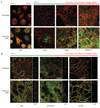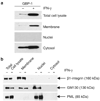Guanylate-binding protein-1 is expressed at tight junctions of intestinal epithelial cells in response to interferon-gamma and regulates barrier function through effects on apoptosis
- PMID: 19079332
- PMCID: PMC2877263
- DOI: 10.1038/mi.2008.62
Guanylate-binding protein-1 is expressed at tight junctions of intestinal epithelial cells in response to interferon-gamma and regulates barrier function through effects on apoptosis
Abstract
Guanylate-binding protein-1 (GBP-1) is an interferon inducible large GTPase involved in endothelial cell proliferation and invasion. In this report, expression and function of GBP-1 were investigated in vitro in intestinal epithelia after exposure to interferon-gamma and in human colonic mucosa from individuals with inflammatory bowel disease (IBD). Interestingly, in contrast to other epithelia, GBP-1 distributed to the plasma membrane in intestinal epithelial cells where it colocalized with the tight junction protein coxsackie- and adenovirus receptor. In addition, expression of GBP-1 was upregulated in colonic epithelia of individuals with IBD. Downregulation of GBP-1 by siRNA resulted in enhanced permeability that correlated with increased apoptosis. Indeed, inhibition of caspase activity prevented the inhibition of barrier formation induced by the loss of GBP-1. These data suggest that GBP-1 is a novel marker of intestinal mucosal inflammation that may protect against epithelial apoptosis induced by inflammatory cytokines and subsequent loss of barrier function.
Figures






Similar articles
-
Guanylate binding protein-1-mediated epithelial barrier in human salivary gland duct epithelium.Exp Cell Res. 2018 Oct 1;371(1):31-41. doi: 10.1016/j.yexcr.2018.07.033. Epub 2018 Jul 22. Exp Cell Res. 2018. PMID: 30044945
-
IFN-γ and TNF-α-induced GBP-1 inhibits epithelial cell proliferation through suppression of β-catenin/TCF signaling.Mucosal Immunol. 2012 Nov;5(6):681-90. doi: 10.1038/mi.2012.41. Epub 2012 Jun 13. Mucosal Immunol. 2012. PMID: 22692453 Free PMC article.
-
Pathophysiological role of guanylate-binding proteins in gastrointestinal diseases.World J Gastroenterol. 2016 Jul 28;22(28):6434-43. doi: 10.3748/wjg.v22.i28.6434. World J Gastroenterol. 2016. PMID: 27605879 Free PMC article. Review.
-
Development, validation and implementation of an in vitro model for the study of metabolic and immune function in normal and inflamed human colonic epithelium.Dan Med J. 2015 Jan;62(1):B4973. Dan Med J. 2015. PMID: 25557335 Review.
-
The JAK-Inhibitor Tofacitinib Rescues Human Intestinal Epithelial Cells and Colonoids from Cytokine-Induced Barrier Dysfunction.Inflamm Bowel Dis. 2020 Feb 11;26(3):407-422. doi: 10.1093/ibd/izz266. Inflamm Bowel Dis. 2020. PMID: 31751457 Free PMC article.
Cited by
-
Gut Barrier Damage and Gut Translocation of Pathogen Molecules in Lupus, an Impact of Innate Immunity (Macrophages and Neutrophils) in Autoimmune Disease.Int J Mol Sci. 2022 Jul 26;23(15):8223. doi: 10.3390/ijms23158223. Int J Mol Sci. 2022. PMID: 35897790 Free PMC article. Review.
-
Enhanced Utilization of Induced Pluripotent Stem Cell-Derived Human Intestinal Organoids Using Microengineered Chips.Cell Mol Gastroenterol Hepatol. 2017 Dec 29;5(4):669-677.e2. doi: 10.1016/j.jcmgh.2017.12.008. eCollection 2018. Cell Mol Gastroenterol Hepatol. 2017. PMID: 29930984 Free PMC article.
-
Intracellular trafficking of guanylate-binding proteins is regulated by heterodimerization in a hierarchical manner.PLoS One. 2010 Dec 7;5(12):e14246. doi: 10.1371/journal.pone.0014246. PLoS One. 2010. PMID: 21151871 Free PMC article.
-
Dietary ganglioside reduces proinflammatory signaling in the intestine.J Nutr Metab. 2012;2012:280286. doi: 10.1155/2012/280286. Epub 2012 Feb 12. J Nutr Metab. 2012. PMID: 22506104 Free PMC article.
-
Current understanding of the interplay between extracellular matrix remodelling and gut permeability in health and disease.Cell Death Discov. 2024 May 27;10(1):258. doi: 10.1038/s41420-024-02015-1. Cell Death Discov. 2024. PMID: 38802341 Free PMC article. Review.
References
-
- Cheng YS, Colonno RJ, Yin FH. Interferon induction of fibroblast proteins with guanylate-binding activity. J. Biol. Chem. 1983;258:7746–7750. - PubMed
-
- Naschberger E, Bauer M, Sturzl M. Human guanylate-binding protein-1 (hGBP-1) characterizes and establishes a nonangiogenic endothelial cell activation phenotype in inflammatory diseases. Adv. Enzyme Regul. 2005;45:215–227. - PubMed
-
- Olszewski MA, Gray J, Vestal DJ. In silico genomic analysis of the human and murine guanylate-binding protein (GBP) gene clusters. J. Interferon Cytokine Res. 2006;26:328–352. - PubMed
-
- Prakash B, Praefcke GJ, Renault L, Wittinghofer A, Herrmann C. Structure of human guanylate-binding protein-1 representing a unique class of GTP-binding proteins. Nature. 2000;403:567–571. - PubMed
Publication types
MeSH terms
Substances
Grants and funding
LinkOut - more resources
Full Text Sources
Research Materials

